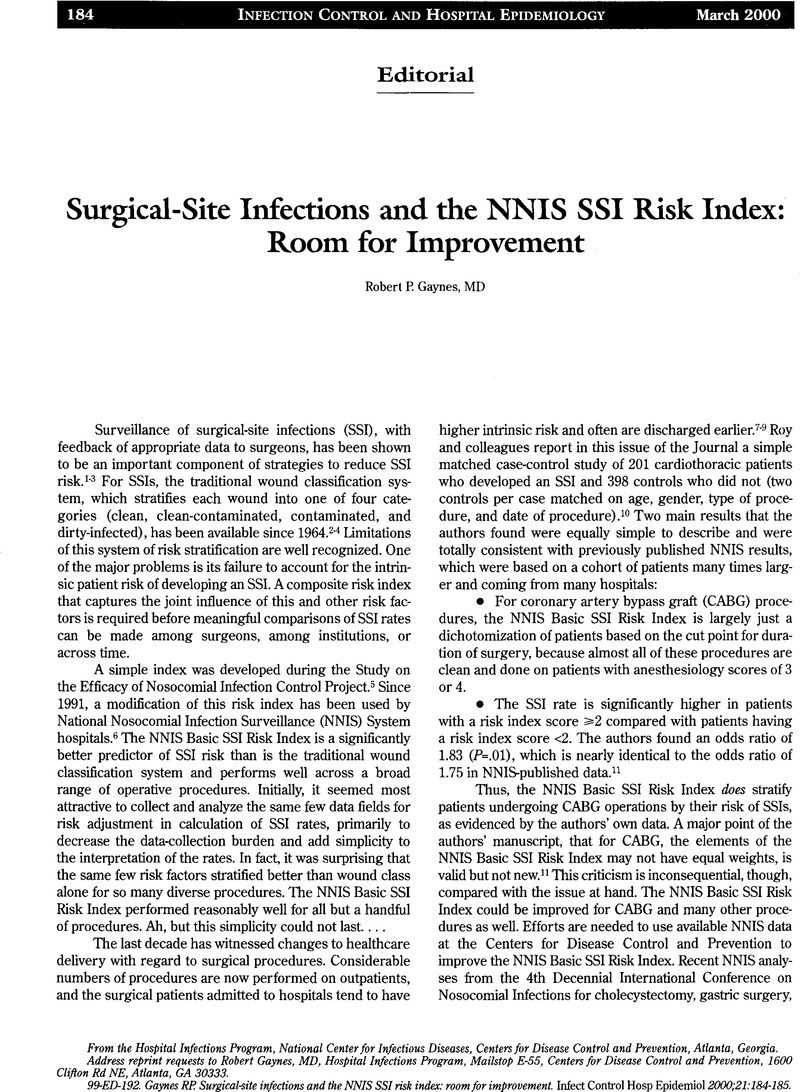Crossref Citations
This article has been cited by the following publications. This list is generated based on data provided by Crossref.
Gaynes, Robert P.
2000.
Surveillance of Surgical-Site Infections: The World Coming Together?.
Infection Control & Hospital Epidemiology,
Vol. 21,
Issue. 5,
p.
309.
Gaynes, Robert P.
2001.
Surgical-Site Infections (SSI) and the NNIS Basic SSI Risk Index, Part II: Room for Improvement.
Infection Control & Hospital Epidemiology,
Vol. 22,
Issue. 5,
p.
266.
Coello, Rosa
Gastmeier, Petra
and
de Boer, Annette S.
2001.
Surveillance of Hospital-Acquired Infection in England, Germany, and The Netherlands Will International Comparison of Rates Be Possible?.
Infection Control & Hospital Epidemiology,
Vol. 22,
Issue. 6,
p.
393.
De Boer, A.S.
Geubbels, E.L.P.E.
Wille, J.
and
Mintjes-De Groot, A.J.
2001.
Risk Assessment for Surgical Site Infections Following Total Hip and Total Knee Prostheses.
Journal of Chemotherapy,
Vol. 13,
Issue. sup4,
p.
42.
Russo, Philip L.
and
Spelman, Denis W.
2002.
A New Surgical-Site Infection Risk Index Using Risk Factors Identified by Multivariate Analysis for Patients Undergoing Coronary Artery Bypass Graft Surgery.
Infection Control & Hospital Epidemiology,
Vol. 23,
Issue. 7,
p.
372.
Soleto, Lorena
Pirard, Marianne
Boelaert, Marleen
Peredo, Remberto
Vargas, Reinerio
Gianella, Alberto
and
Stuyft, Patrick Van der
2003.
Incidence of Surgical-Site Infections and the Validity of the National Nosocomial Infections Surveillance System Risk Index in a General Surgical Ward in Santa Cruz, Bolivia.
Infection Control & Hospital Epidemiology,
Vol. 24,
Issue. 1,
p.
26.
Goldrick, Barbara A.
2003.
Surgical-Site Infections.
AJN, American Journal of Nursing,
Vol. 103,
Issue. 4,
p.
64AA.
Taylor, E W
Duffy, K
Lee, K
Hill, R
Noone, A
Macintyre, I
King, P M
and
O'Dwyer, P J
2003.
Surgical site infection after groin hernia repair.
British Journal of Surgery,
Vol. 91,
Issue. 1,
p.
105.
Thomas, C
Cadwallader, H.L
and
Riley, T.V
2004.
Surgical-site infections after orthopaedic surgery: statewide surveillance using linked administrative databases.
Journal of Hospital Infection,
Vol. 57,
Issue. 1,
p.
25.
Lepelletier, Didier
Perron, Stéphanie
Bizouarn, Philippe
Caillon, Jocelyne
Drugeon, Henri
Michaud, Jean-Luc
and
Duveau, Daniel
2005.
Surgical-Site Infection After Cardiac Surgery: Incidence, Microbiology, and risk Factors.
Infection Control & Hospital Epidemiology,
Vol. 26,
Issue. 5,
p.
466.
Lepelletier, D.
Perron, S.
and
Michaud, J.L.
2005.
Médiastinites après chirurgie cardiaque : incidence, microbiologie et facteurs de risque.
Antibiotiques,
Vol. 7,
Issue. 1,
p.
18.
Terzi, C.
2006.
Antimicrobial prophylaxis in clean surgery with special focus on inguinal hernia repair with mesh.
Journal of Hospital Infection,
Vol. 62,
Issue. 4,
p.
427.
Gaynes, Robert P.
and
Platt, Richard
2006.
Monitoring Patient Safety in Health Care: Building the Case for Surrogate Measures.
The Joint Commission Journal on Quality and Patient Safety,
Vol. 32,
Issue. 2,
p.
95.
Geubbels, Eveline L. P. E.
Grobbee, Diederick E.
Vandenbroucke-Grauls, Christina M. J. E.
Wille, Jan C.
and
Boer, Annette S. de
2006.
Improved Risk Adjustment for Comparison of Surgical Site Infection Rates.
Infection Control & Hospital Epidemiology,
Vol. 27,
Issue. 12,
p.
1330.
Russo, Philip L.
Bull, Ann
Bennett, Noleen
Boardman, Claire
Burrell, Simon
Motley, Jane
Berry, Kylie
Friedman, N. Deborah
and
Richards, Michael
2006.
The establishment of a statewide surveillance program for hospital-acquired infections in large Victorian public hospitals: A report from the VICNISS Coordinating Centre.
American Journal of Infection Control,
Vol. 34,
Issue. 7,
p.
430.
Friedman, N. Deborah
Bull, Ann L.
Russo, Philip L.
Leder, Karin
Reid, Christopher
Billah, Baki
Marasco, Silvana
McBryde, Emma
and
Richards, Michael J.
2007.
An Alternative Scoring System to Predict Risk for Surgical Site Infection Complicating Coronary Artery Bypass Graft Surgery.
Infection Control & Hospital Epidemiology,
Vol. 28,
Issue. 10,
p.
1162.
Cruickshank, Marilyn
Ferguson, John
and
Bull, Ann
2009.
Reducing harm to patients from health care associated infection: the role of surveillance. Chapter 3: Surgical site infection – an abridged version.
Healthcare infection,
Vol. 14,
Issue. 3,
p.
109.
Daneman, Nick
Simor, Andrew E.
and
Redelmeier, Donald A.
2009.
Validation of a Modified Version of the National Nosocomial Infections Surveillance System Risk Index for Health Services Research.
Infection Control & Hospital Epidemiology,
Vol. 30,
Issue. 6,
p.
563.
Huskins, W. Charles
and
Goldmann, Donald A.
2009.
Feigin and Cherry's Textbook of Pediatric Infectious Diseases.
p.
3076.
Olsen, Margaret A.
Higham-Kessler, James
Yokoe, Deborah S.
Butler, Anne M.
Vostok, Johanna
Stevenson, Kurt B.
Khan, Yosef
and
Fraser, Victoria J.
2009.
Developing a Risk Stratification Model for Surgical Site Infection after Abdominal Hysterectomy.
Infection Control & Hospital Epidemiology,
Vol. 30,
Issue. 11,
p.
1077.





